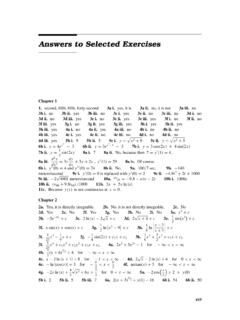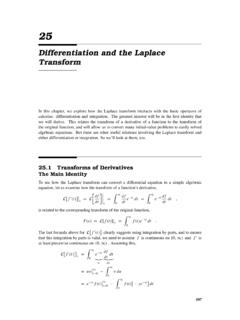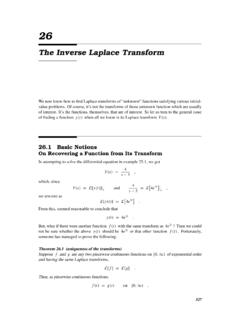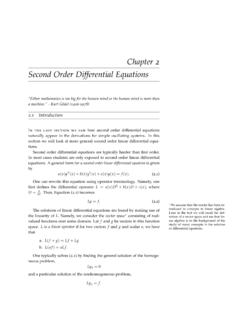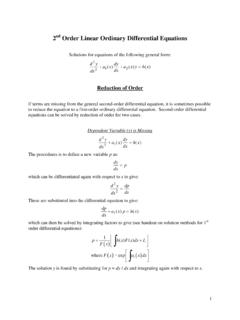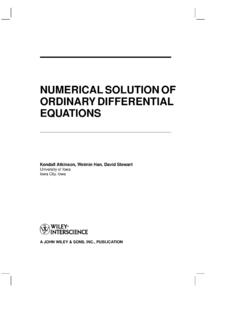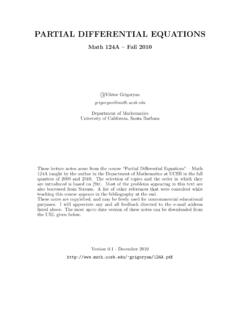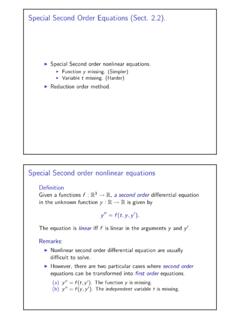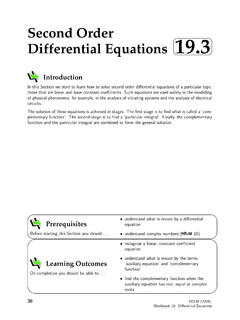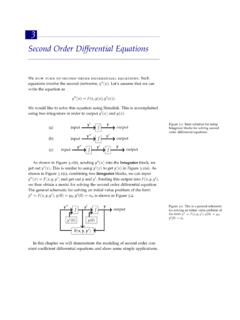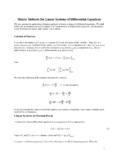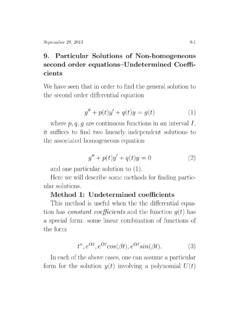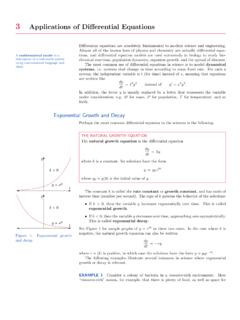Transcription of Reduction of Order - University of Alabama in Huntsville
1 13 Reduction of OrderWe shall take a brief break from developing the general theory for linear differential equationsto discuss one method (the Reduction of Order method ) for finding the general solution to anylinear differential equation. In some ways, this method mayremind you of the material in chapter11. Indeed, part of the method involves solving a higher- Order equation via first- Order methodsas discussed in chapter 11. The general theory developed in chapter 12 will not, however, beused to any great extent. Instead, the material developed here will help us finish that generaltheory (at least partially confirming the suspicions raisedat the end of the chapter), and will helplead us to the complete result on constructing general solutions from particular why worry about completing that general theory if any linear differential equation canbe completely solved by this Reduction of Order method ?
2 Because this method requires thatone solution to the differential equation already be limits the method s , serious practical difficulties arise when the differential equation to be solved is of orderthree or more. Still, there are situations where the method is of practical value, and it will helpus confirm suspicions we already have about general yes, there is another reason to develop this method: A rather powerful method for solvingnonhomogeneous equations , the variation of parameters method described in chapter 23, issimply a clever refinement of the Reduction of Order The General IdeaThe Reduction of Order method is a method for converting any linear differential equation toanother linear differential equation of lower Order , and then constructing the general solutionto the original differential equation using the general solution to the lower- Order equation.
3 Ingeneral, to use this method with anNth- Order linear differential equationa0y(N)+a1y(N 1)+ +aN 2y +aN 1y +aNy=g,we need one known nontrivial solutiony1=y1(x)to the corresponding homogeneous differ-ential equation. We then try a substitution of the formy=y1uwhereu=u(x)is a yet unknown function (andy1=y1(x)is the aforementioned knownsolution). Plugging this substitution into the differential equation then leads to a linear differential283284 Reduction of Orderequation foru. As we will see, becausey1satisfies the homogeneous equation, the differentialequation foruends up being of the formA0u(N)+A1u(N 1)+ +AN 2u +AN 1u =g remarkably, there is no ANu term. This means we can use the substitutionv=u ,as discussed in chapter 11, to rewrite the differential equation foruas a(N 1)th-orderdifferential equation forv,A0v(N 1)+A1v(N 2)+ +AN 2v +AN 1v= we have reduced the Order of the equation to be solved.
4 If a general solutionv=v(x)for this equation can be found, then the most general formulaforucan be obtained fromvby integration (sinceu =v). Finally then, by going back to the original substitution formulay=y1u, we can obtain a general solution to the original differential method is especially useful for solving second - Order homogeneous linear differentialequations since (as we will see) it reduces the problem to oneof solving relatively simple first- Order differential equations . Accordingly, we will first concentrate on its use in finding generalsolutions to second - Order , homogeneous linear differential equations . Then we will brieflydiscuss using Reduction of Order with linear homogeneous equations of higher Order , and withnonhomogeneous linear Reduction of Order for Homogeneous LinearSecond- Order EquationsThe MethodHere we lay out the details of the Reduction of Order method for second - Order homogeneouslinear differential equations .
5 To illustrate the method, we ll use the differential equationx2y 3xy +4y=0 .Note that the first coefficient,x2, vanishes whenx=0 . From comments made in chapter 12(see page 261), we should suspect thatx=0 ought not be in any interval of interest for thisequation. So we will be solving over the intervals(0, )and( ,0).Before starting the Reduction of Order method, we need one nontrivial solutiony1to ourdifferential equation. Ways for finding that first solution will be discussed in later chapters. Fornow let us just observe that ify1(x)=x2,thenx2y1 3x y1 +4y1=x2d2dx2[x2] 3xddx[x2]+4[x2]=x2[2 1] 3x[2x] +4x2=x2[2 (3 2)+4] 0 !=0 . Reduction of Order for Homogeneous Linear second - Order Equations285 Thus, one solution to the above differential equation isy1(x)= already stated, this method is for finding a general solution to some homogeneous linearsecond- Order differential equationay +by +cy=0(wherea,b, andcare known functions witha(x)never being zero on the interval ofinterest).
6 We will assume that we already have one nontrivial particular solutiony1(x)to thisgeneric differential our example (as already noted), we will seek a general solution tox2y 3xy +4y=0.( )The one (nontrivial) solution we know isy1(x)= , now, are the details in using the Reduction of Order method to solve the (x)is a function yet to be determined. To simplify the pluggingintothe differential equation , go ahead and compute the corresponding formulas for thederivativesy andy using the product rule:y =(y1u) =y1 u+y1u andy =(y ) =(y1 u+y1u ) =(y1 u) +(y1u ) =(y1 u+y1 u )+(y1 u +y1u )=y1 u+2y1 u +y1u .For our example,y=y1u=x2uwhereu=u(x)is the function yet to be determined. The derivatives ofyarey =(x2u) =2xu+x2u andy =(y ) =(2xu+x2u ) =(2xu) +(x2u ) =(2u+2xu )+(2xu +x2u )=2u+4xu +x2u.
7 The formulas just computed fory,y andy into the differential equation, grouptogether the coefficients foruand each of its derivatives, and simplify as far as possible.(We ll do this with the example first and then look at the general case.)286 Reduction of OrderPlugging the formulas just computed above fory,y andy into equation( ), we get0=x2y 3xy +4y=x2[2u+4xu +x2u ] 3x[2xu+x2u ]+4[x2u]=2x2u+4x3u +x4u 6x2u 3x3u +4x2u=x4u +[4x3 3x3]u +[2x2 6x2+4x2]u=x4u +x3u +0 that theuterm drops out! So the resulting differential equation foruis simplyx4u +x3u =0,which we can further simplify by dividing outx4,u +1xu =0In general, plugging in the formulas foryand its derivatives into the given differentialequation yields0=ay +by +cy=a[y1 u+2y1 u +y1u ]+b[y1 u+y1u ]+c[y1u]=ay1 u+2ay1 u +ay1u +by1 u+by1u +cy1u=ay1u +[2ay1 +by1]u +[ay1 +by1 +cy1] is, the differential equation becomesAu +Bu +Cu=0whereA=ay1,B=2ay1 +by1andC=ay1 +by1 + remember,y1is a solution to the homogeneous equationay +by +cy=0.
8 Consequently,C=ay1 +by1 +cy1=0 ,and the differential equation foruautomatically reduces toAu +Bu =0 .Theuterm always drops out! find the general solution to the second - Order differential equation just obtained foru,Au +Bu =0 ,via the substitution method discussed in section : Reduction of Order for Homogeneous Linear second - Order Equations287(a)Letu =v(and, thus,u =v =dv/dx) to convert the second - Order differentialequation foruto the first- Order differential equation forv,Advdx+Bv=0 .(It is worth noting that this first- Order differential equation will be both linear andseparable.)(b)Find the general solutionv(x)to this first- Order equation. (Since it is both linearand separable, you can solve it using either the procedure developed for first-orderlinear equations or the approach developed for first- Order separable equations .)
9 (c)Using the formula just found forv, integrate the substitution formulau =vtoobtain the formula foru,u(x)= v(x) t forget all the arbitrary our example, we obtainedu +1xu = and, thus,v =u this becomesdvdx+1xv= ,dvdx= is a relatively simple separable first- Order has one constantsolution,v=0. To find the others, we divide through byvand proceed asusual with such equations :1vdvdx= 1x 1vdvdxdx= 1xdx ln|v|= ln|x|+c0 v= e ln|x|+c0 v= ec0x ec0, this simplifies tov=Ax,which also accounts for the constant solution (whenA=0).Sinceu =v, it then follows thatu(x)= v(x)dx= Axdx=Aln|x|+ of , plug the formula just obtained foru(x)into the first substitution,y=y1u,used to convert the original differential equation foryto a differential equation resulting formula fory(x)will be a general solution for that original differentialequation.
10 (Sometimes that formula can be simplified a little. Feel free to do so.)In our example, the solution we started with wasy1(x)=x2. Combined withtheu(x)just found, we havey=y1u=x2[Aln|x|+B].That is,y(x)=Ax2ln|x|+Bx2is the general solution to equation ( ).An Observation About the SolutionLet us observe that, in the example, the general solution obtained wasy(x)=Ax2ln|x|+Bx2,which can be viewed as a linear combination of the two functionsy1(x)=x2andy2(x)=x2ln|x|.Since theAandBin the above formula fory(x)are arbitrary constants, andy2is givenby that formula forywithA=1 andB=0 , it must be that thisy2is another particularsolution to our original homogeneous linear differential equation. What s more, it is clearly nota constant multiple ofy1. This should strengthen an earlier suspicion that the general solutionto a homogeneous linear second - Order differential equation can be written as just such a will later examine more closely the general form for general solution toany homogeneouslinear differential equation.





